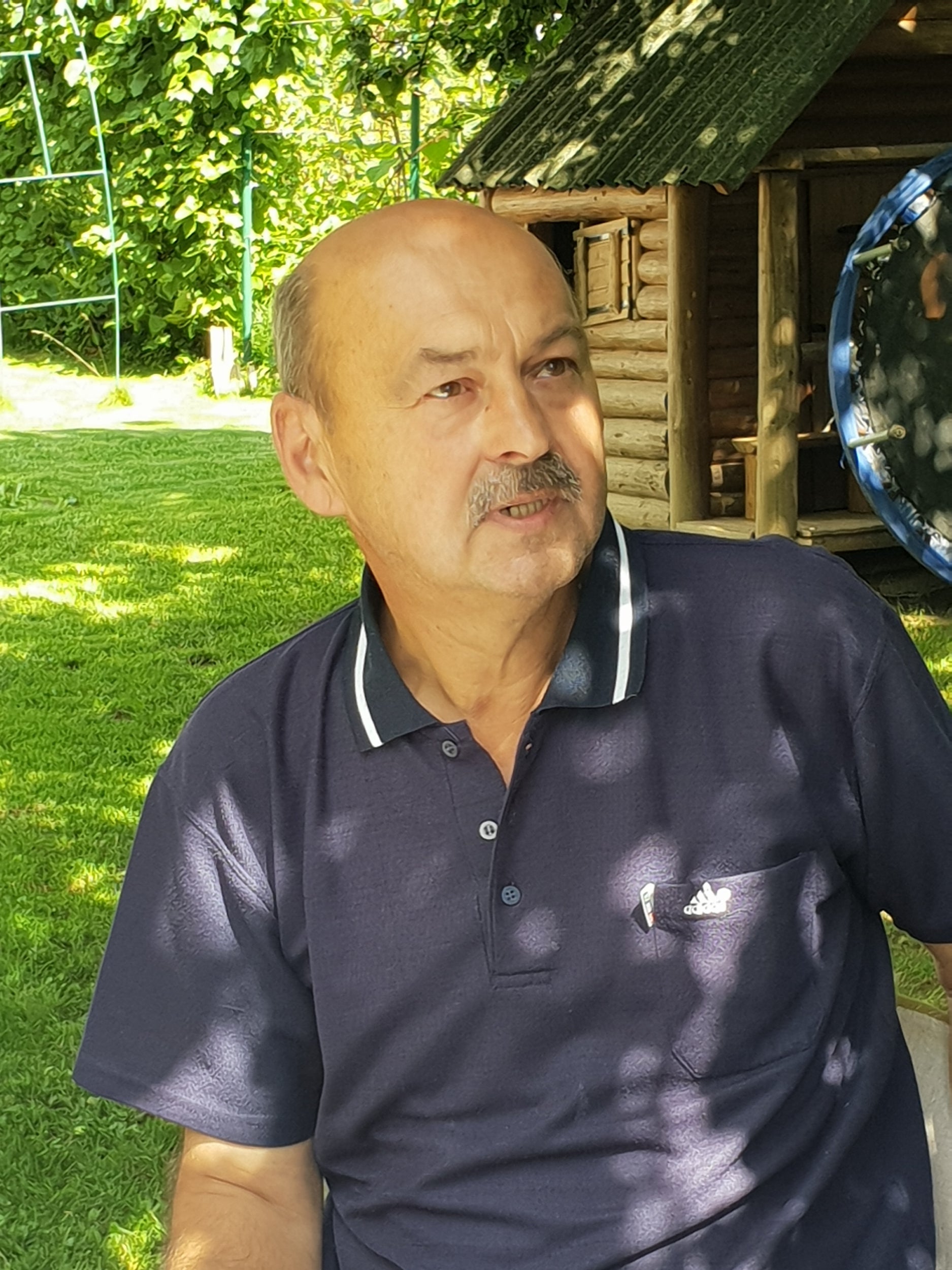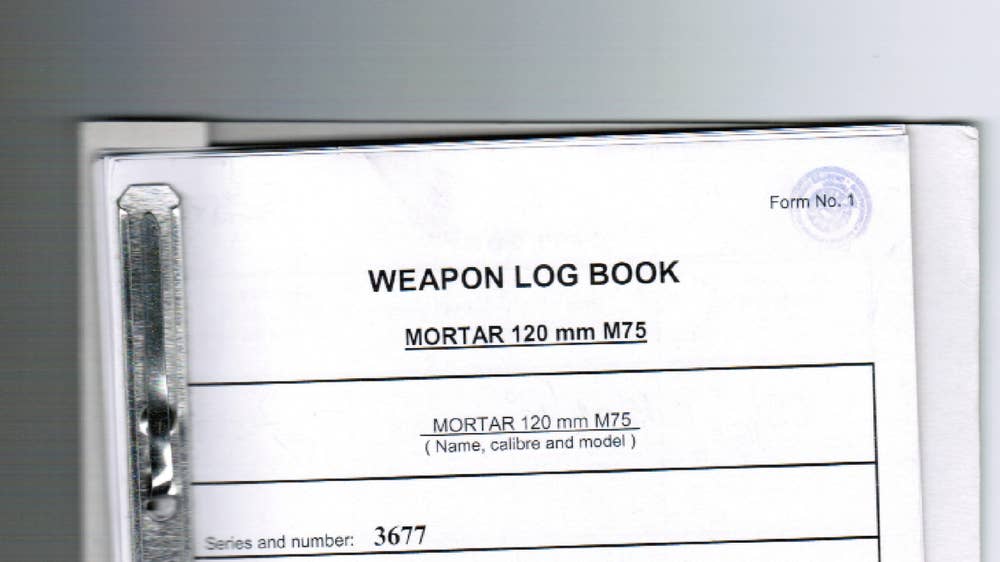Exclusive: The documents, some lying amid smashed guns and shrapnel, provided the most intriguing paper trail yet discovered of just who is producing the weapons that have armed the Assad regime’s most ferocious Islamist opponents
In the basement of a bombed-out al-Qaeda arms storage building in eastern Aleppo last year, I found a weapons log book from a mortar factory in Bosnia – with the handwritten name of one of their senior officials, Ifet Krnjic, on each page. It was dispatched from the Balkans with a cargo of 500 120mm mortars in January 2016. But now, in the forested heart of central Bosnia, I have found Mr Krnjic, who says his company sent the arms to Saudi Arabia.
Sitting on the lawn of his home south of the weapons-manufacturing town of Novi Travnik, he brings his finger down onto the first page of the log book which I showed him. “This is my signature! Yes, that’s me!” Krnjic exclaims loudly. “It’s a warranty for the 120mm mortar launcher – this is Nato standard. It [the shipment] went to Saudi Arabia. It was part of a supply of 500 mortars. I remember the Saudi shipment well. They [the Saudis] came to our factory to inspect the weapons at the beginning of 2016.”
This is astonishing. Not only does Krnjic, the 64-year old newly retired weapons control director of the BNT-TMiH factory at Novi Travnik, acknowledge his signature – but he says he recalls the visits of Saudi officials and military personnel to inspect the mortars before their shipment to Riyadh, and insists all such sales were strictly in accordance with the legal end-user certificates which his company obtained from all customers, stating that the weapons were to be used only by the armed forces of the nations which purchased them.

Five-hundred mortars is a massive shipment of weapons – most European armies don’t have that many in their individual inventories – and some of them at least appear to have ended up in the hands of Bashar al-Assad’s Islamist Nusrah Front/al-Qaeda enemies in northern Syria within six months of their dispatch from Bosnia 1,200 miles away. Because the mortars left Bosnia on 15 January 2016 under a BNT-TMiH factory guarantee for 24 months – numbered 779 and with a weapons series number of 3677 – the documents now in The Independent’s possession must have reached Aleppo by late July of 2016, when Syrian government troops totally surrounded the enclave held by armed factions including Nusrah, Isis and other Islamist groups condemned as “terrorists” by the United States.
When The Independent asked the Saudi authorities to respond to the documents in its possession and their discovery in eastern Aleppo, the Saudi embassy in London replied that the Kingdom did not give “practical or other support to any terrorist organisation [including Nusrah and Isis] in Syria or any other country” and described the allegations raised by The Independentas “vague and unfounded”. It said Saudi Arabia had been a “leading voice within the international community in support of a diplomatic solution to the conflict in Syria, while at the same time working with our neighbours and allies to counter the growth of forces of extremism”. It made no comment on the weapon log book and arms control coupons, photographs of which The Independent had asked it to examine.
However, it is clear that Saudi Arabia’s strict Wahabi faith has inspired Nusrah, Isis and other violent Islamist groups in Syria. Saudi Arabia has often been accused of arming the rebels in Syria, and religious publications from Riyadh have been found in towns formerly held by the Islamist groups. Besides, Saudi Arabia has demanded the overthrow of Bashar al-Assad and his government in Damascus.

In the last stages of the 2016 siege of Aleppo, Syrian and Russian forces were condemned in the west for the daily bombing of civilian areas of eastern Aleppo, and video footage provided constant images of dead and wounded men, women and children. During this period, however, the city’s Islamist defenders – most of whom later departed under a promise of safe passage for jihadi-held areas of Idlib province – fired barrages of mortar shells at government-held western Aleppo.
In the weeks that followed the mid-December surrender of the fighters in eastern Aleppo, the square miles of wreckage remained sown with mines and booby-traps. There were whole districts still cordoned off when I entered three former military barracks of the Islamist groups in February 2017, rubble sometimes blocking my path; stones, bricks, sheet metal and bomb fragments strewn across the roads and inside still standing, though badly damaged, buildings. Inside one of these, lying half-concealed amid iron fragments and field dressings, I found piles of discarded documents containing firing instructions for machine guns and mortars, all of them in English.
They also included weapons shipment papers and arms instruction booklets from Bosnia and Serbia, the pages still damp from winter rains and some stained by footprints. I stuffed as many as I could in the satchel I always carry in wars, later finding – in another building – a Bulgarian weapons shipment paper for artillery shells. In a deep basement of a third building in the Ansari district, with the words Jaish al-Mujaheddin (Army of the Holy Fighters) crudely painted but still visible on the front, its upper floors clearly bombed by Syrian or Russian jets, lay dozens of empty boxes for anti-armour weapons, all marked with their maker’s name – the Hughes Aircraft Company, of California. The boxes were labelled “Guided Missile Surface Attack” with stock numbers starting with the computer code “1410-01-300-0254”.
These papers, some of them lying amid smashed guns and pieces of shrapnel, provide the most intriguing paper trail yet discovered of just who is producing the weapons that have armed the Assad regime’s most ferocious Islamist opponents – and how they apparently reach the fighters of Syria via countries ‘friendly’ to the west. While claiming that he would have to “search” for documents on the end-user of the 2016 mortar shipment, Adis Ikanovic, the managing director of the Novi Travnik factory, acknowledged to me in his head office that most of his company’s exports went to “Saudi Arabia, probably”. An email reminder to Ikanovic six days after our meeting, for copies of the 2016 end-user certificate papers for the mortar shipment, elicited no reply.

Milojko Brzakovic, managing director of the Zastava arms factory in Serbia, looks through the arms manuals I found in Aleppo – including a 20-page instruction document for the powerful Coyote MO2 machine gun which his company manufactures – and says “there is not a single country in the Middle East which did not buy weapons from Zastava in the past 15 years”. He agrees that the documents I presented to him, which included a 52-page manual for his company’s 7.62mm M84 machine gun, which I also found in the Aleppo ruins beneath a bombed apartment bloc which had ‘Nusrah’ painted in Arabic on its wall, were published by Zastava in Serbia, and that Saudi Arabia and the Emirates were among his customers.

Ifet Krnjic’s account of the mortar shipment from BNT-TMiH in Bosnia is both precise and detailed. “When the Saudis came to our factory to inspect at the beginning of 2016, there was a Saudi ‘minister’… and some Saudi officers who also came to inspect the weapons before receiving them. The officers wore civilian clothes. The minister was in a robe. All our production after the [Bosnian] war is under the control of the Americans and Nato who are always coming here… and they know each and every piece of our weapons which go outside our factory.”
Krnjic, who lives in the tiny village of Potok Krnjic, Bosnian hamlets sometimes carry the names of extended families, south of Novi Travnik, describes how he recognised Nato officers visiting the plant, one of them “a Canadian officer, a black guy whose name is Stephen”. Ikanovic, the BNT-TMiH boss, confirms that all weapons shipments, including those to Saudi Arabia, were checked by the European Union Force Althea (EUFOR), the successor to Nato’s SFOR, and set up under the 1995 Dayton accords which ended the Bosnian war. Ikanovic says an Austrian general visits his factory for inspections, identified to me by other employees as Austrian two star Major General Martin Dorfer, the EUFOR commander. Krnjic says weapons from the plant are exported by Tuzla airport or through Sarajevo.
The Saudis, Krnjic tells me, “were never complaining because we have had a very good reputation for a long time, not only for our weapons but for who can give the shortest delivery date… I know I should not say all of this, but Nato and the EU have given us the green light to do this. Ours is the only mortar that can shoot from asphalt. Each mortar has a base plate, but other base plates [from other countries’ mortars] break – they can only be used on soft ground. With ours, the mortars can also be carried in sacks – they are three shells, one barrel, you shoot at a building and then you disappear. Only Chinese mortars are better than ours – I saw them in Iraq.”
Documents found in bombed Nusrah militia basements in eastern Aleppo




It transpires that although Krnjic has never visited Syria, he was employed in a weapons factory built by BNT-TMiH in Iraq in 1986, during the eight year Iran-Iraq war. “I was working inside the factory in Iraq – I wasn’t waging a war there” he says. “The factory there was more modern than ours [in Novi Travnik] – we were in Fallujah and Ramadi. By that time, we were already doing rocket launchers for Saddam, 260mm with a range of 500km. I saw Saddam three times.”
But Novi Travnik’s fortunes declined when the Bosnian war began in 1992, its once 10,000-strong workforce today reduced to fewer than 900. Much of the factory compound is now overgrown with rusted steel walls around some of its machine shops. Krnjic, a member of Bosnia’s Social Democratic Party and a veteran of the country’s civil war, retired from the company some months before Ikanovic was appointed managing director.
“I cannot export anything without a licence with the approval of five different ministers here in Bosnia, and it [the contract] is overlooked by Nato,” Ikanovic said. “We can only sell to countries which are on Nato’s ‘white list’.” Like Krnjic, and Brzakovic in Serbia, he says that his arms company must receive an internationally recognised end-user certificate for any arms export – but agrees that exporters had neither an obligation nor any way of preventing the further shipment of its weapons to third parties once they had arrived at their initial destination.


